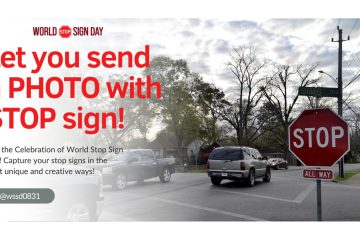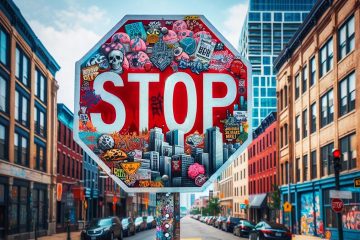How does a stop sign in art transform from a traffic signal into a powerful symbol? This article explores five revolutionary ways artists have utilized the stop sign in art to address societal issues, from pop art icons like Warhol to political street art and digital media.
Key Takeaways
- The stop sign serves as a versatile symbol in art, reflecting social justice, rebellion, and urgent societal issues in various movements, particularly in pop art.
- Artists like Andy Warhol, Banksy, and Roy Lichtenstein effectively use the stop sign to critique consumer culture, provoke public discourse, and convey powerful narratives.
- Stop signs are also significant in political art and contemporary digital formats, symbolizing movements for peace, equality, and ecological awareness, while also appearing in children’s art and iconic cinema.
The Stop Sign as a Symbol in Pop Art
In the vibrant world of pop art, the stop sign has emerged as a potent symbol, representing a call for social change and justice. Artists within this movement have utilized the stop sign to highlight urgent issues such as war, inequality, and consumerism. The bold, recognizable image of the stop sign acts as a universal symbol, demanding attention and action against various social injustices.
The stop sign’s prominence in pop art also embodies themes of rebellion against consumerism and authority, reflecting societal issues through its bold imagery. Three key figures in the pop art movement—Andy Warhol, Banksy, and Roy Lichtenstein—have each integrated the stop sign into their works, using it to convey powerful messages about the need for change.
Andy Warhol’s Traffic Signs
Andy Warhol, a towering figure in the pop art movement, famously incorporated everyday symbols into his work to critique modern culture. His integration of traffic signs, including stop signs, was a commentary on the superficiality of contemporary society and advertising. Warhol’s recontextualization of these familiar symbols unveiled the intricacies of mass production and commercialization.
Warhol’s use of stop signs specifically critiqued the consumer culture, showcasing the intersection of art and societal norms. His works often highlighted the repetitive nature of mass-produced goods, underscoring the commercialization of modern life. This approach not only amplified the visual impact of his pieces but also provoked viewers to question the world around them.
Banksy’s Street Art
Banksy, a name synonymous with provocative street art, has made a significant impact by using stop signs as canvases for his politically charged graffiti. His art often transforms these signs into symbols of activism, critiquing social issues such as war and governance. Banksy’s pieces provoke public dialogue and challenge the status quo, urging audiences to reflect on critical societal issues.
The strategic placement of his art in public spaces enhances its accessibility, allowing a broader audience to engage with his messages. Banksy’s use of stop signs not only draws attention to the artwork itself but also emphasizes the need for awareness and change in society. This approach has cemented his reputation as a powerful voice in contemporary art, and he’ll continue to inspire future generations.
Roy Lichtenstein’s Comic Style
Roy Lichtenstein, known for his comic-style paintings, incorporated stop signs to enhance dramatic storytelling and visual impact. His works blend vibrant colors and dot patterns, creating engaging narratives that reflect popular culture. The inclusion of stop signs in his pieces adds a layer of visual intrigue and emotional depth.
Lichtenstein’s use of stop signs serves as a narrative device, enhancing the storytelling within his art. These symbols contribute to the overall narrative and emotional impact, making his comic-inspired pieces even more compelling.
Lichtenstein’s blend of comic art with stop signs created a unique visual language that continues to resonate with audiences.
Stop Signs in Political Art
The stop sign has also played a pivotal role in political art, symbolizing the urgent need to halt war, inequality, and oppression. Its bold, unmistakable imagery makes it an effective tool for conveying powerful messages about societal issues. In political art, the stop sign frequently reflects themes of consumer culture, authority, and dissent.
Artists like Banksy have frequently reimagined stop signs to challenge political narratives and provoke public discourse. The use of stop signs in political art serves to challenge viewers, urging them to reconsider societal norms and the status quo.
This powerful symbol has been used in various contexts, including anti-war posters, the civil rights movement, and environmental campaigns.
Anti-War Posters
Anti-war posters have long utilized stop signs to convey messages of peace and the cessation of violence. These posters effectively use the stop sign to represent a collective call to end military aggression and promote peace. The bold imagery of the stop sign makes it an ideal symbol for such urgent messages.
Notable examples of anti-war posters featuring stop signs have had a significant impact on public perception and activism. These artworks not only reflect societal demands for peace but also serve as powerful tools for advocacy and change. The stop sign’s clear and direct message resonates deeply in the context of anti-war movements.
Civil Rights Movement
During the civil rights movement, artworks featuring stop signs were used to demand an end to racial discrimination and promote equality. These pieces served as powerful symbols advocating for social justice and the urgent need to stop racial inequality. The stop sign’s bold imagery made it an effective tool for conveying these crucial messages.
Artworks from the civil rights movement incorporating stop signs highlighted the pressing need for change and equality. These powerful images captured the spirit of the movement and continue to inspire contemporary discussions about race and justice. The stop sign’s use in this context underscores its versatility as a symbol of social change.
Environmental Campaigns
In environmental campaigns, stop signs have been used to emphasize the need for ecological awareness and conservation efforts. These campaigns often utilize the stop sign to highlight the urgent need for action against environmental destruction. The bold, recognizable imagery of the stop sign makes it an effective symbol for promoting environmental advocacy.
Educational contexts also incorporate stop signs to promote awareness about environmental issues. By using the stop sign, these campaigns encourage individuals to pause and consider their role in ecological conservation. This approach has proven effective in driving public awareness and action.
Stop Signs in Contemporary Digital Art
In the realm of contemporary digital art, stop signs have become powerful tools for ecological and social commentary. Artists use stop signs to highlight urgent issues, prompting audiences to consider their role in societal change. The digital platform allows for innovative and immersive ways to engage with these symbols.
Various forms of contemporary digital art, including augmented reality, online protest art, and video game art, incorporate stop signs to provoke thought and action. These digital mediums offer new opportunities for artists to convey their messages, making the stop sign a versatile and impactful symbol in the digital age.
Augmented Reality Installations
In augmented reality (AR) installations, stop signs are transformed into interactive elements that engage users in a virtual context. These installations merge the physical and digital worlds, allowing for dynamic interactions with digital stop signs. This immersive experience enhances viewer engagement and emphasizes the significance of the stop sign.
AR installations respond to the viewer’s presence and actions, creating a unique, interactive experience. This innovative approach not only highlights the importance of the stop sign but also encourages users to reflect on its symbolic meaning in contemporary art.
The blend of AR and traditional symbols offers new dimensions for artistic expression.
Online Protest Art
Online protest art has emerged as a powerful platform for addressing contemporary social issues, often utilizing stop signs to highlight urgent matters. These digital artworks prompt discussions about societal concerns, such as cyberbullying and data privacy. The stop sign’s bold imagery makes it a compelling symbol for these themes.
Digital protest art incorporating stop signs effectively raises awareness and encourages public discourse on pressing issues. The accessibility of digital platforms allows these messages to reach a wide audience, amplifying their impact.
This form of art continues to challenge viewers and provoke thought about their roles in societal change.
Video Game Art
In video games, stop signs often serve as elements of environmental storytelling, conveying narrative context and thematic depth. These symbols prompt players to pause and consider their next moves or the consequences of their actions. The integration of stop signs enhances the realism of game environments and player interaction.
Game designers use stop signs to create immersive experiences, reinforcing the significance of game design in storytelling. By incorporating these symbols, video games not only entertain but also provoke thought about societal norms and individual choices. The use of stop signs in this context underscores the intersection of art and interactive media.
The Stop Sign in Children’s Art
Children’s art often features stop signs as symbols of safety and adherence to rules. These depictions reflect children’s understanding of their environment and the importance of following safety rules. The stop sign’s bold, recognizable shape makes it an ideal symbol for conveying these themes.
Children use stop signs in various contexts, such as school projects, storybooks, and drawings, to illustrate their interpretations of safety and authority. These creative expressions not only showcase their artistic talents but also their comprehension of important life lessons.
School Projects
In school projects, children often incorporate stop signs to emphasize themes of road safety and community awareness. These projects reflect their understanding of traffic rules and the importance of safety in their daily lives. The creative use of stop signs in school assignments showcases children’s imaginative interpretations of these concepts.
Children’s use of stop signs in their artwork demonstrates their grasp of safety rules and their ability to apply them creatively. These projects not only educate but also engage children in meaningful ways, reinforcing the importance of road safety and community awareness.
Storybooks Illustrations
Illustrations of stop signs in children’s storybooks often serve as teaching tools for important life lessons about safety. These illustrations convey vital lessons about responsible behavior and decision-making. The stop sign’s clear and direct message makes it an effective symbol for these educational purposes.
By incorporating stop signs, storybooks provide children with relatable and understandable symbols that reinforce the importance of following rules. These story illustrations not only entertain but also educate, making them valuable tools in children’s learning and development.
Kid’s Drawings
Children’s drawings frequently feature stop signs as creative elements, reflecting their understanding of traffic rules and safety concepts. These imaginative depictions showcase how children interpret and internalize the symbols they encounter in their daily lives. The stop sign, with its bold, recognizable shape, serves as an ideal subject for children’s artistic expression.
These drawings often blend fantasy with reality, illustrating children’s unique perspectives on safety and authority. Children’s artwork with stop signs highlights their awareness of traffic rules and the importance of adhering to them.
These creative expressions provide valuable insights into how children perceive and engage with their environment.
Iconic Movie Scenes Featuring Stop Signs
In cinema, stop signs often serve as critical plot devices, symbolizing authority, a moment of pause, or a significant realization. These symbols are used to enhance storytelling and convey deeper thematic elements. Three iconic films—“Ferris Bueller’s Day Off,” “The Truman Show,” and “Zootopia”—have effectively utilized stop signs to underscore key moments and themes.
These movies demonstrate the versatility of the stop sign as a cinematic tool, reflecting various aspects of human experience and societal norms. Whether representing rebellion, control, or societal order, the stop sign’s presence in these films adds a layer of meaning that resonates with audiences.
“Ferris Bueller’s Day Off” (1986)
In the beloved classic “Ferris Bueller’s Day Off,” Ferris and his friends encounter a stop sign during their day of adventure. This moment symbolizes their defiance against societal norms and authority figures, reflecting themes of youth freedom and rebellion. The stop sign serves as a visual cue for the characters’ challenge to the limitations imposed by their everyday lives.
This iconic scene highlights the film’s broader narrative of breaking free from conformity and embracing the spontaneity of youth. The stop sign’s symbolic presence underscores the characters’ journey and the film’s enduring appeal.
“The Truman Show” (1998)
In “The Truman Show,” the stop sign represents a pivotal moment in Truman’s life as he begins to awaken to the reality of his orchestrated existence. This symbol embodies the tension between conformity and individual discovery, highlighting Truman’s quest for truth and freedom. The stop sign serves as a visual metaphor for the constraints placed on Truman by the show’s creator.
Ultimately, the stop sign symbolizes both Truman’s entrapment and his eventual pursuit of authenticity and liberation. This powerful imagery reinforces the film’s themes of control and the struggle against societal norms.
“Zootopia” (2016)
In the animated film “Zootopia,” the stop sign is used to illustrate the tension between law enforcement and societal order. This symbol underscores themes of justice and equality, reflecting the complexities of maintaining order in a diverse community. The placement of the stop sign impacts the protagonist’s journey, highlighting the challenges faced by law enforcement in the film.
The stop sign’s presence in “Zootopia” serves as a critique of law enforcement and the influence of societal rules on individual freedom. This symbolism adds depth to the film’s narrative, making it a powerful commentary on justice and societal expectations.
Summary
The stop sign’s journey through various artistic landscapes reveals its powerful role as a symbol of social change, authority, and rebellion. From pop art and political campaigns to contemporary digital art and children’s drawings, the stop sign has been reimagined and repurposed to convey profound messages. Artists like Andy Warhol, Banksy, and Roy Lichtenstein have each utilized this symbol to critique societal norms and provoke thought.
In cinema, the stop sign has served as a critical plot device, enhancing storytelling and reflecting deeper thematic elements. Whether in “Ferris Bueller’s Day Off,” “The Truman Show,” or “Zootopia,” the stop sign’s presence adds layers of meaning that resonate with audiences. As we continue to explore the intersection of art and societal symbols, the stop sign stands out as a compelling reminder of the power of visual imagery in shaping our understanding of the world.
Frequently Asked Questions
Why is the stop sign a popular symbol in art?
The stop sign is a popular symbol in art due to its universal recognition and ability to convey powerful messages about authority, rebellion, and social change. This bold imagery effectively highlights critical societal issues, making it a compelling choice for artists.
How has Andy Warhol used stop signs in his art?
Andy Warhol used stop signs in his art to critique consumer culture and mass production, recontextualizing these symbols to reveal the complexities of modern society.
What is the significance of stop signs in political art?
Stop signs in political art are significant as they symbolize a call to halt war, inequality, and oppression, effectively conveying messages that advocate for societal change.
How are stop signs used in children’s art?
Stop signs in children’s art often symbolize safety and the importance of following rules, showcasing their understanding of traffic safety concepts. This representation highlights their engagement with the world around them.
Can you give examples of movies that feature stop signs as critical plot devices?
Movies such as “Ferris Bueller’s Day Off,” “The Truman Show,” and “Zootopia” effectively use stop signs as critical plot devices, symbolizing themes of rebellion, control, and societal order that deepen their narratives.


